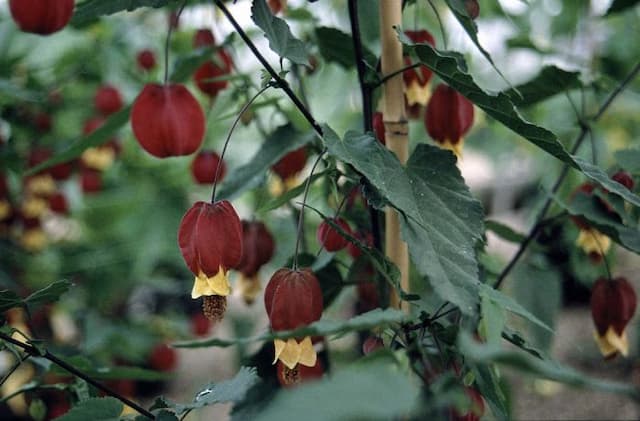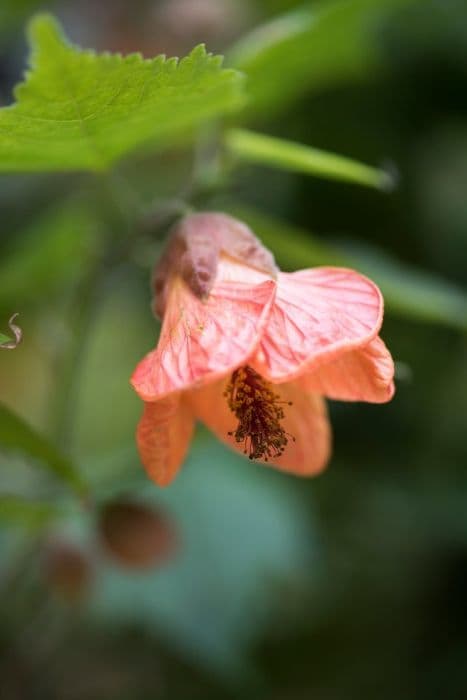Hollyhock 'Halo Apricot' Alcea rosea 'Halo Apricot' (Halo Series)

ABOUT
'Halo Apricot' is a perennial to 2m tall with lobed green leaves and, in summer, long flower spikes bearing large, apricot-pink flowers with contrasting deep pink centres
About this plant
 Names
NamesFamily
Malvaceae
Synonyms
Halo Apricot Hollyhock, Halo Series Hollyhock
Common names
Alcea rosea 'Halo Apricot'.
 Characteristics
CharacteristicsLife cycle
Biennials
Foliage type
Deciduous
Color of leaves
Green
Flower color
Apricot
Height
6 feet (1.83 meters)
Spread
2 feet (0.61 meters)
Plant type
Herb
Hardiness zones
3-9
Native area
Europe
Benefits
 General Benefits
General Benefits- Aesthetic Appeal: Adds vibrant color and height to gardens with its apricot-colored blooms.
- Attracts Pollinators: A source of nectar for bees, butterflies, and hummingbirds, promoting biodiversity.
- Low Maintenance: Once established, it requires minimal care, making it suitable for gardeners of all skill levels.
- Drought Tolerance: Exhibits tolerance to dry periods, reducing the need for frequent watering.
- Cottage Garden Classic: A popular choice for traditional cottage garden designs, due to its height and floral display.
- Vertical Interest: Adds vertical dimension to planting schemes, an excellent backdrop for lower-growing plants.
- Long Blooming Season: Offers a long period of bloom, often from late spring to early fall, providing prolonged garden interest.
- Self-Seeding: Can self-seed under suitable conditions, ensuring a continual presence in the garden year after year.
- Can Tolerate Different Soils: Adaptable to a range of soil types, although it prefers well-drained soil.
- Late Season Bloomer: Provides flower interest when many other plants have finished blooming, extending the color display in gardens.
 Medical Properties
Medical Properties- This plant is not used for medical purposes.
 Air-purifying Qualities
Air-purifying QualitiesThis plant is not specifically known for air purifying qualities.
 Other Uses
Other Uses- As a natural dye: Alcea rosea petals can be used to create a range of soft peach or apricot hues in the natural dyeing of fabrics.
- In crafting paper: The petals of Alcea rosea can be incorporated into handmade papers for an attractive texture and color.
- As an educational tool: Alcea rosea can be used to teach botany and plant life cycles in schools and educational programs.
- In themed gardens: This plant is excellent for use in historically themed gardens, such as a medieval or renaissance garden.
- For attracting butterflies: The colorful flowers of Alcea rosea are known to attract butterflies, adding another layer of beauty to a garden.
- As a photography subject: Alcea rosea's striking appearance makes it a favorite among photographers and artists for still life images.
- For floral crafts: Dried Alcea rosea flowers can be used in creating potpourri or decorative wreaths and arrangements.
- In culinary presentations: The blooms can be used as an edible garnish for salads and desserts (though they should not be consumed in large quantities).
- As part of a sensory garden: With its soft petals and tall stature, Alcea rosea is great for gardens designed to stimulate the senses.
- In compost: Once the plant has completed its lifecycle, it can be composted to help create nutrient-rich soil for other garden plants.
Interesting Facts
 Feng Shui
Feng ShuiThe Hollyhock is not used in Feng Shui practice.
 Zodiac Sign Compitability
Zodiac Sign CompitabilityThe Hollyhock is not used in astrology practice.
 Plant Symbolism
Plant Symbolism- Fertility - Alcea rosea, commonly known as Hollyhock, has been associated with fertility due to its abundant blooms and rapid growth.
- Abundance - The full, lush flowers of the Hollyhock symbolize a plentiful supply, representing success and wealth.
- Resilience - Hollyhocks can grow in challenging conditions, symbolizing the ability to overcome obstacles and thrive.
- Heartfelt Ambition - Their tall spikes reaching toward the sky can evoke the symbolism of aiming high and holding aspirations.
- Generosity - Due to its prolific nature and tendency to self-seed, Hollyhocks are seen as a symbol of sharing wealth and prosperity.
- Survival - Historically, Hollyhocks were planted near outhouses, leading to their symbolizing the ability to survive and find beauty in less-than-ideal circumstances.
 Water
WaterThe Hollyhock 'Halo Apricot' should be watered deeply, allowing water to soak into the soil to encourage deep root growth. It is best to water the plant early in the morning and avoid wetting the foliage to reduce the risk of foliar diseases. The frequency of watering depends on weather conditions and soil type, but generally, the plant should be watered once a week with about 1 to 1.5 inches of water. This frequency should be increased during hot, dry spells. Drought-stressed plants will benefit from a generous soak, using several gallons of water, as opposed to shallow watering.
 Light
LightHollyhocks, including the 'Halo Apricot', thrive in full sun where they can receive at least six hours of direct sunlight each day. The best spot for this plant is an area with unobstructed exposure to the sun, so ensure there are no shade-casting obstacles nearby. These plants can also tolerate light shade, but too much shade may lead to a reduction in bloom quantity and health.
 Temperature
TemperatureHollyhocks prefer a moderate climate and typically grow well when daytime temperatures are between 60 and 80 degrees Fahrenheit. They are hardy to a certain extent, with a minimum temperature tolerance down to about -20 degrees Fahrenheit, but ideally should not be subjected to prolonged periods below freezing. To encourage vigorous growth, ensure that 'Halo Apricot' is planted in a location where the temperature stays within this ideal range throughout the growing season.
 Pruning
PruningPruning Hollyhock 'Halo Apricot' is necessary to maintain its appearance and health. Remove dead or yellowing leaves throughout the season to encourage air circulation and minimize disease. After flowering, cut the stalks back to just above the ground level. This should be done annually, preferably in late fall after the plant has finished blooming, to encourage new growth in the spring.
 Cleaning
CleaningAs needed
 Soil
SoilThe best soil mix for Hollyhocks, such as the 'Halo Apricot', is well-draining and rich in organic matter. To create an ideal growing medium, mix garden soil with compost and peat moss in equal parts. The soil pH should be slightly alkaline, between 6.0 and 8.0. Regular mulching can help maintain soil moisture and temperature.
 Repotting
RepottingHollyhocks, such as the 'Halo Apricot', are biennials or short-lived perennials and do not typically require frequent repotting. They are often treated as annuals and replanted each year from seeds, rather than being repotted. If your Hollyhock is in a container and becomes root-bound, repot it in the spring before active growth begins.
 Humidity & Misting
Humidity & MistingHollyhocks, including the 'Halo Apricot', are tolerant of a wide range of humidity levels and do well in the average outdoor conditions found in their growing zones. They do not require high humidity and can thrive in the natural humidity found in most garden environments.
 Suitable locations
Suitable locationsIndoor
Place in bright, indirect light; ensure good air circulation.
Outdoor
Full sun; well-draining soil; shelter from strong winds.
Hardiness zone
3-9 USDA
 Life cycle
Life cycleThe Halo Apricot Hollyhock (Alcea rosea 'Halo Apricot') begins its life cycle when seeds are sown after the last frost of spring, either directly into the soil or started indoors for early sprouts. Seedlings emerge after 1-2 weeks and will spend the first year primarily developing foliage and a strong root system as a biennial plant. In the second year, the plant begins its rapid vertical growth, producing tall, sturdy stalks that can reach up to 5-6 feet tall, with heart-shaped leaves arranged in a rosette at the base. During the midsummer of the second year, the Hollyhock begins its blooming phase, displaying a profusion of large, colorful flowers with a distinctive halo at the center, which can continue to bloom until early fall. After flowering, the plant sets seeds in round capsules; these seeds can be collected for propagation or will self-sow if left unattended, facilitating the plant's natural reseeding process. As winter approaches, the plant typically dies back, completing its life cycle, but if seeds have fallen, they may give rise to new seedlings the following spring.
 Propogation
PropogationPropogation time
Spring-Early Summer
The most popular method of propagating Alcea rosea 'Halo Apricot', commonly known as Hollyhock, is by sowing seeds. This process is best done in late summer to early fall or, in colder climates, seeds can be started indoors about 6-8 weeks before the last expected frost. To propagate by seeds, scatter them on top of a well-draining soil mix and press them lightly into the substrate without covering, as they need light to germinate. Keep the soil consistently moist but not waterlogged. Germination should occur within 2 to 3 weeks at temperatures between 70 to 75 degrees Fahrenheit (21 to 24 degrees Celsius). Once seedlings develop their first set of true leaves and reach a height of about 2 to 3 inches (5 to 7.5 centimeters), they can be transplanted to their final location in the garden, maintaining a spacing of about 18 to 24 inches (45 to 60 centimeters) apart to accommodate their mature size.









